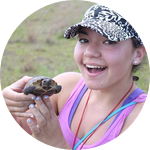About This Project
An unstudied population of Gopher tortoises, a Threatened species, exists on Cumberland Island, Georgia USA. In the summer of 2016, I conducted a pilot survey on one large population on the Island. In 2017, the goal is to survey the remaining Island to determine the total population size & characteristics. Information on this keystone species must be known in order to effectively manage conservation areas vs. human use areas on the Island.
Ask the Scientists
Join The DiscussionWhat is the context of this research?
Gopher tortoises are considered a keystone species in their native pine savannah habitat because the burrows they dig provide shelter for over 300 other species in that habitat as well. Due to habitat loss, urban sprawl, and over exploitation, the land dwelling Gopher tortoise is now listed as a threatened species in much of the southeastern United States. Therefore, any information regarding the current status, distribution, density, and human impacts that may affect this species is critically important to the long term viability and management of this species, especially isolated remnant populations like the one on Cumberland island.
What is the significance of this project?
Prior to my pilot study, no research or data on the Gopher tortoises of Cumberland Island exists, with only anecdotal references to this population found in history books written about the Island. Much data is needed in terms of how many, what ages, where are they concentrated? This research is also time sensitive as there is a current proposal going through the approval process by one of the private land owners to build up to 10 additional houses on the Island. Knowing the exact areas that these tortoises are found and prefer on Cumberland together with the migration movement data that will be obtained from this study will help assure that these little guys are taken into account in planning any type of human impact activities.
What are the goals of the project?
The main goal of my study is to determine the population size, age classes present (juveniles, sub adults, adults), and gender ratios of the tortoises on the Island. All burrow locations will also be mapped using GIS with notes on whether they are occupied and active burrows or inactive ones. Using the purchased radio transmitter and motion camera equipment, I will track their daily activity and migration patterns. This information is vital in terms of recommending protected areas along with other management decisions. Finally, temperature monitoring discs will be used to determine preferred temperatures in case relocation becomes necessary.
Budget
These materials are critical for gathering the needed population data on this keystone species, only found in the Southeastern U.S. Each piece of equipment will be used in the daily surveying, tracking, and monitoring of the tortoises throughout the summer of 2017. This project will be used as my Senior Thesis project and I am very excited with the possibility of doing this project and sharing all my results with all of you. In addition, this experience will help me decide the direction of my graduate career.
Endorsed by
 Project Timeline
Project Timeline
I plan to arrive on Cumberland Island on June 1st, 2017. Although field work can sometimes depend on weather and the cooperation of the research animal, my plan is to spend 6-8 weeks searching for, counting, tracking, and monitoring the Gopher tortoises on Cumberland Island (while giving updates to this group). I will then spend the Fall semester analyzing and writing up the results for publication and to orally present at scientific meetings.
May 08, 2017
Project Launched
Jun 01, 2017
Arrive and set-up equipment on Cumberland Island
Jun 15, 2017
Complete Island Survey for burrows/tortoises
Jun 20, 2017
Set-up motion cameras, radio transmitters, and temperature monitor discs on select burrows/tortoises
Jul 18, 2017
Monitor tortoises for 4 weeks, then collect all equipment and data
Meet the Team
Alexandria Gagne
I've always had an interest in animals even at a young age. From catching frogs in the backyard pond of where I lived, to following the rabbits through the woods. I would always try to bring frogs and other little critters home with me, although it sometimes never worked out in my favor. Even though I wasn’t allowed to have outside animals inside, I would construct a home for them outside where I could care and nurture them. Being surrounded by wildlife was the highlight of my childhood, something I have continued into my adulthood.
Being surrounded by animals growing up has encouraged me to pursue wildlife studies. My interest in animals has brought me to Jacksonville University in Florida where I am currently pursuing my degree. I feel very fortunate to have the opportunity to continue my passion of reptiles by working under the mentorship of Dr. John Enz, who has performed several studies on Gopher tortoises. I also want to mention Hunter Moore who will be collaborating with me and assisting me in the field this summer should this project be funded. He is currently a student in the Wildlife Program at Maryville College in Tennessee and works under the direction of Dr. David Unger.
Additional Information
If funded, I look forward to posting my progress, keeping everyone informed, and having all of you follow me and the tortoises on Cumberland Island!
Project Backers
- 35Backers
- 100%Funded
- $2,011Total Donations
- $57.46Average Donation

